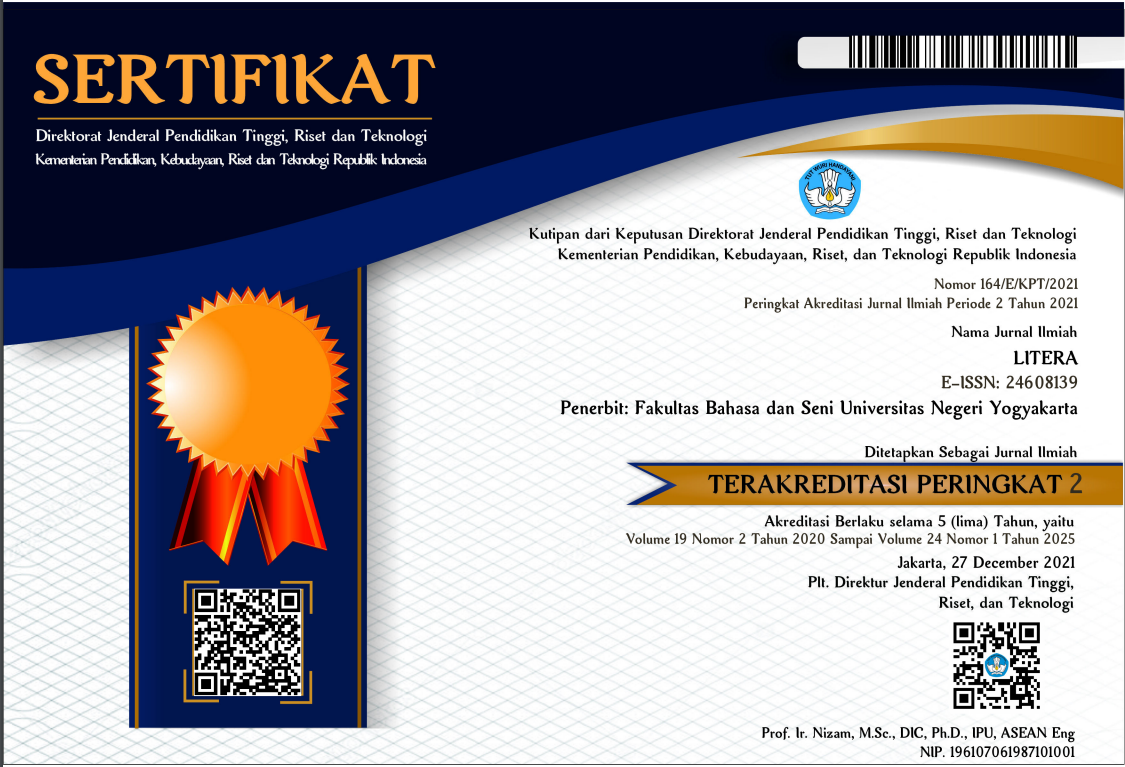CHAOS, MORAL DECADENCE, AND BETRAYAL (SATIRE IN "DI TEPI KALI BEKASI" NOVEL BY PRAMOEDYA ANANTA TOER)
Desvian Bandarsyah, Jurusan Pendidikan Sejarah, UHAMKA, Jakarta, Indonesia
Wildan Insan Fauzi, Departemen Pendidikan Sejarah, FPIPS, Universitas Pendidikan Sejarah, Indonesia
Abstract
Indonesian revolution in 1945-1949 is a remarkable moment for all of Indonesian people which is full of heroic spirit. Interestingly, Pramoedya portrayed the revolution moment in the novel entitled “Di Tepi Kali Bekasi” with different point of view in which he used a sarcasm style of language to depicts the conditions and deliver his critics about behaviors of people from various clusters at that time. Therefore, this current study is motivated by interest to explore how satirical narrative is used in the novel. A qualitative content analysis with context unit was employed as a research method to describe and analyze in detail the description and characteristics of satire in the novel. Specifically, a concept of satire intended in this study is sarcasm, social criticism, and irony. Based on the results of analysis, there are some satirical elements in the novel namely social chaos, public unrest, bandits and robbery, betrayal, generation conflicts, youth nationalism, and immoral behavior and corruption of the army. In addition, according to Pramoedya's view, revolution is considered as an animalistic age where the revolution of soul is more important and needed by the nation instead of the armed revolution. Due to those facts, independence remains as a fake independence where unheard voice of the periphery and moral destruction are still the main problem. Generally, it is found that the satirical root in the novel is laid on two things namely Pramoedya's direct experience as a soldier and his ideas he wants to convey in the novel.
Kata Kunci: Di Tepi Kali Bekasi, novel sejarah, Pramoedya Ananta Toer, satire
CHAOS, DEKANDENSI MORAL, DAN PENGKHIANATAN
(Satir dalam Novel Di Tepi Kali Bekasi karya Pramoedya Ananta Toer)
Abstrak
Revolusi fisik 1945-1949 merupakan periode yang disakralkan dan digambarkan penuh dengan semangat kepahlawanan. Namun, Pramoedya menggambarkan revolusi Indonesia dalam novel di Tepi kali Bekasi dengan gaya bahasa satir yang berisi kritikan tajam dan ironi terhadap perilaku berbagai kalangan. Tujuan penelitian ini adalah mendeskripsikan narasi satir dalam novel Di Tepi Kali Bekasi karya Pramoedya Ananta Toer. Penelitian ini menggunakan metode analisis isi kualitatif untuk menggambarkan dan menganalisis secara detail deskripsi dan karakteristik satir dalam novel. Analisis data yang digunakan adalah unit konteks. Konsep satir yang dimaksud adalah sindiran, kritik sosial, dan ironi. Unsur satir yang terdapat dalam novel adalah kekacauan sosial (chaos), keresahan masyarakat, bandit dan rampok, pengkhianatan, konflik generasi, nasionalisme pemuda, serta perilaku amoral dan korupsi tentara. Cara pandang Pramoedya mengenai revolusi adalah revolusi sebagai zaman kebinatangan, revolusi jiwa lebih berhasil daripada revolusi bersenjata, kemerdekaan hanya kemerdekaan semu, suara kaum pinggiran, dan kehancuran moral. Akar satir dalam novel Di Tepi Kali Bekasi bertumpu pada dua hal, yaitu pengalaman langsung Pramoedya sebagai tentara dan gagasan-gagasan yang ingin disampaikannya dalam novel.
Kata Kunci: Di tepi kali bekasi, novel sejarah, Pramoedya Ananta Toer, Satir
Keywords
Full Text:
PDFReferences
Aminuddin. (2009). Pengantar Apresiasi Karya Sastra. Bandung: Sinar baru Algesindo.
Aveling, H. (ed. and trans.). (1975). A note on the author. In A heap of ashes by Pramoedya Ananta Toer. St Lucia: University of Queensland Press.
Bangsawan, A.R. (2017). Pramoedya Ananta Toer, Politik dan Sastra. Yogyakarta: Media Pressindo.
Bostock, D. (2017). Anehnja Hubungan Ajah dan Anak Ini’, Indonesia and the Malay World. 45(131), 108-126, DOI: 10.1080/13639811.2017.1290895.
Dewi, N. (2007). Every Book Has a Voice: A Postcolonial Reading of Gadis Pantai and Larasati, Asian Englishes, 10:2, 82-91, DOI: 10.1080/13488678.2007.10801214.
Eriyanto. (2015). Analisis Isi: Pengantar Metodologi untuk Penelitian Ilmu Komunikasi dan Ilmu-Ilmu Sosial Lainnya. Jakarta: Prenadamedia Grup.
Eriyanto. (2013). Analisis Naratif: Dasar-Dasar dan Penerapannya dalam Analisis Teks Berita Media. Jakarta: Prenadamedia Grup.
Farid, H. (2008). Pramoedya dan Historiografi Indonesia. Dalam buku ”Perspektif Baru Penulisan Sejarah Indonesia. Jakarta: Yayasan Obor Indonesia.
Graf, A. (2007). ‘Cyberpram’: Perceptions of Pramoedya Ananta Toer on the Internet. Indonesia and the Malay World. 35(103), 293-312, DOI: 10.1080/13639810701676797.
Gunawan, R. (2017). Kajian Heuristik Pada Novel Sejarah Pramoedya Ananta Toer. Dalam Margana Dkk (ed). Menemukan Historiografi Indonesiasentris. Yogyakarta: Ombak
Herriman.N. (2010). Objects of manipulation: the people and the rural village in Indonesia’s culture wars. South East Asia Research, 18(3), 451–470, doi: 10.5367/sear.2010.0003.
Hertz, S. K. (2018). Using Historical Fiction in The History Classroom. tersedia di www.yale-new haven.edu[online]. Diakses tanggal 15 April 2018.
Lindquist, T. (2008). Why and How I Teach with Historical Fiction. tersedia di http www.teacher.scholastic.com [online]. Diakses tanggal 15 Desember 2018.
Murti, S.E. (2013). Peribahasa, Sastra Lama, dan Majas Plus Sinonim, Antonim, dan EYD. Jakarta: Mata Elang Media.
Niekerk, C. (2017). Colonial/Postcolonial Chronotopes in Pramoedya Ananta Toer's The Girl from the Coast. Symposium: A Quarterly Journal in Modern Literatures, 71:1, 14-27.
Prasetyono, D.S. (2011). Buku Lengkap Majas dan Peribahasa. Yogyakarta: Diva Press.
Rangkuti, B. (1963). Pramoedya Ananta Toer dan Karja Seninja. Jakarta: Gunung Agung.
Raybin, D. (2009). Muslim Griselda: The Politics of Gender and Religion in Geoffrey Chaucer's Clerk's Tale and Pramoedya Ananta Toer's The Girl from the Coast. Exemplaria, 21:2, 179-200.
Ricklefs, M.C. (2005). Sejarah Indonesia Modern 1200-2004. Jakarta: PT Serambi Ilmu Semesta.
Teeuw, A. (1995). Revolusi Indonesia dalam Imajinasi Pramoedya Ananta Toer. dalam Jurnal Kalam, 6, 4-47.
Teeuw, A. (1997). The ideology of nationalism in Pramoedya Ananta Toer's fiction. Indonesia and the Malay World, 25(73), 252-269, DOI: 10.1080/13639819708729903
Toer, P. A. (1995). Di Tepi Kali Bekasi. Jakarta : Hasta Mitra.
Tsao, T. 2012. The evolution of Java-men and Revolutionaries: A fresh look at Pramoedya Ananta Toer’s Buru Quartet. South East Asia Research, 20(1), 103–131 doi: 10.5367/sear.2012.0088.
Vickers, A. (2013). A History of Modern Indonesia. 2nd edn. Cambridge: Cambridge University Press.
DOI: https://doi.org/10.21831/ltr.v18i1.21146
Refbacks
- There are currently no refbacks.
______________________
__________________________________________________________________________________________________
Litera Journal is published by the Faculty of Languages, Arts, and Culture Universitas Negeri Yogyakarta in collaboration with Himpunan Sarjana Kesusasteraan Indonesia (HISKI)
The International Journal of Linguistic, Literature, and Its Teaching at http://http://journal.uny.ac.id/index.php/litera/ is licensed under a Creative Commons Attribution-ShareAlike 4.0 International License
__________________________________________________________________________________________________















